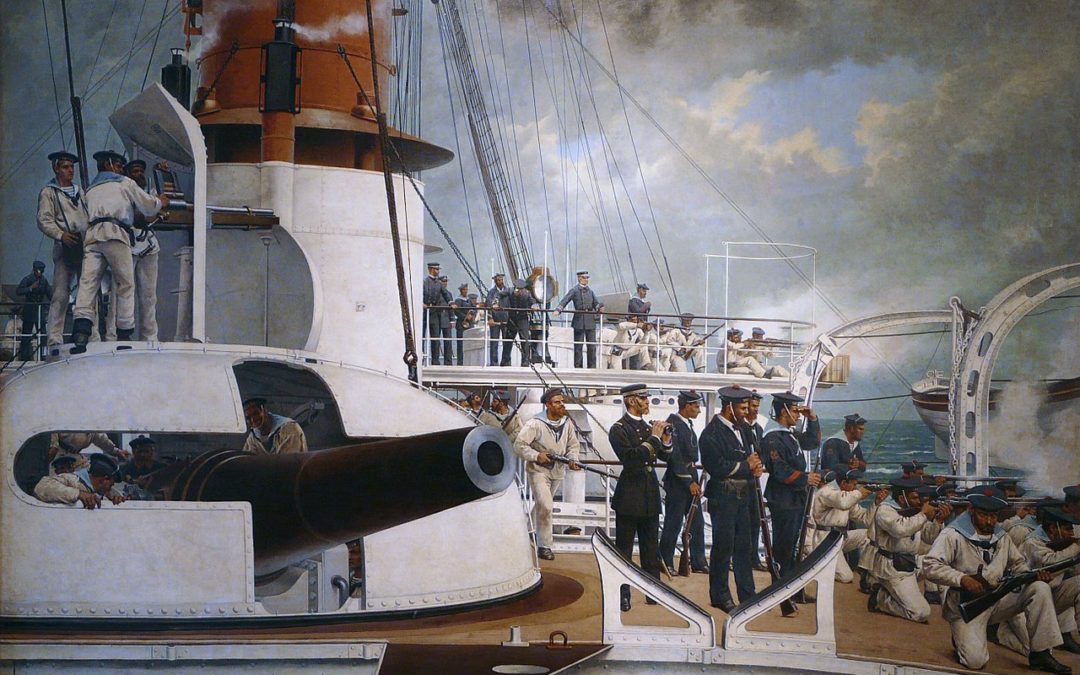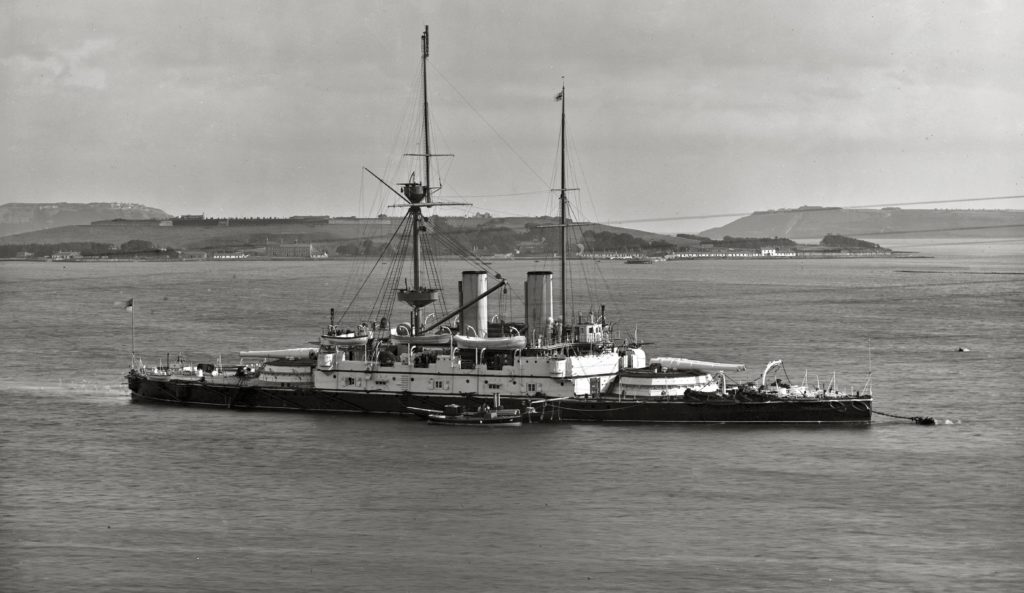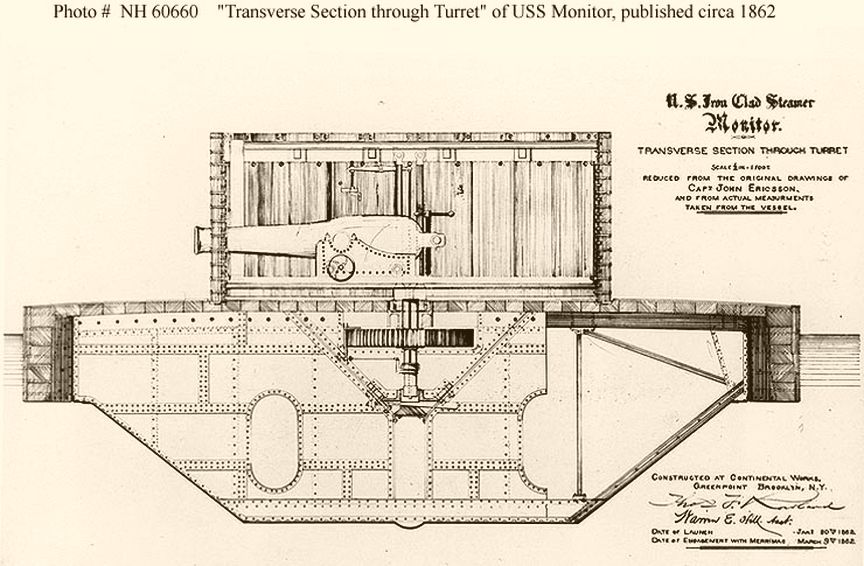It’s been said that English is a language that pursues other languages down dark alleys and mugs them for vocabulary, then riffles their pockets for more, and that’s certainly true of a fair number of naval engineering terms. Words such as ‘barbette’, ‘casemate’ and others were not originally English – they were purloined, and the way that happened is as interesting as the story of the hardware itself. The French, inevitably, have had quite a bit to do with it, and that’s not too surprising. French, after all, is the language from which so many military terms have migrated into English.
Here are a few of those words, with click-through links to articles on the hardware. Note that different sources provide slightly different spellings, meanings or dates for the origin of these words, because those origins are often vague and also because research into English words is ongoing. So the way such words entered English has to take the form of a discussion. But that’s etymology for you.
Barbette
The French term ‘barbette’ came from land warfare, and referred to the technique of firing a cannon over the top of a parapet. This was described as ‘en barbette’. The word was then applied to the way naval cannons were mounted in the top of an armoured cylinder aboard some warships – often French – during the mid-to-late nineteenth century. This system evolved into a form with an armoured gun-house atop during the 1890s, which soon became known as a ‘turret’.
For more on barbettes at sea, here’s an article on HMS Collingwood, one of the first large British barbette ships.
Battleship
This word was formally adopted by the Royal Navy in 1887 to describe its largest and most powerful vessels, which until then had sometimes been known informally as ‘battleships’, but more usually had been given terms that described their engineering – ‘barbette ship’, ‘turret ship’, ‘central-battery ship’ and so on. However, the word ‘battleship’ itself had far older origins.
For those details, have a look at this article on the origins of the word battleship.
Casemate
This word appears to have arrived in English via the Italian casa matta, of uncertain derivation but usually meaning a fortified or protected space from which guns could be fired. It was apparently used in this sense as early as the 1590s. Like so many terms for land fortifications, the term was later adopted for naval use, and was applied in the 1850s to centrally-mounted batteries. By the 1890s, secondary guns were often being placed in mountings spaced along the side of a hull, which were dubbed ‘casemates’.
For more on naval casemates, check out this article on battleship secondary armament.
Mine
This is one of many ordinary English words derived from old French, in this case during the thirteenth century. Its military meaning is thought to have originated in the fourteenth century and originally meant digging underneath a fortification so as to collapse it. By the seventeenth century it also meant digging explosives into place. Curiously, the term ‘miner’ also had a brief nautical application in the 1890s, meaning a vessel that laid mines.
Torpedo
The word ‘torpedo’ originated from the Latin verb torpēre, for which the closest English meaning is ‘torpid’, as in immobile. It seems to have entered English via the muscle-cramping effects of being struck by an electric flatfish, which apparently caused that fish to get the name Torpedo as early as 1520. The word gained a naval use in the late eighteenth century to describe an explosive charge brought up against the side of a ship.
The modern meaning evolved from developments in the mid-late nineteenth century, when the term was applied to a device for carrying a charge at the end of a spar protruding from the bows of a small and fast vessel. Robert Whitehead invented the self-propelled ‘automobile torpedo’ in 1866. The term ‘automobile’ was needed to distinguish it from ‘spar torpedoes’, but when the latter fell out of favour the qualifier was dropped, and the word ‘torpedo’ gained its modern military meaning.
The use of ‘torpedo’ as a plain English verb meaning ‘destroyed’ or ‘damaged’ – as in, ‘that plan’s been torpedoed’ – was apparently first noted in 1879.
Check out this article on an unusual coal torpedo design – a secret weapon deployed by the Confederacy during the United States Civil War.
Turret
The English word turret – originally spelt ‘tourette’, among other variants – originated in Middle English of the thirteenth century, itself derived from the Latin ‘turris’. In military terms it originally referred to a fortified tower.
In the late 1850s, Captain Cowper Phipps Coles of the Royal Navy devised a system for putting guns into a revolving gun-house afloat, for which he filed a patent in March 1859. Almost simultaneously, Swedish inventor John Ericsson produced a similar system, which was deployed on the USS Monitor in 1861. Reputedly neither was the first to come up with the idea: Theodore Ruggles Timby had, apparently, also invented the concept of a revolving naval gun mounting in the 1840s.
Irrespective of the first to develop it for naval use, the fact remains that these devices were called ‘turrets’ and that the term derived from old castle terminology. For information on one of the last old-style turret ships, check out this article on the first HMS Hood.
So there you have it: how a few of the words used in naval technology made their way into English. Check out my book The Battlecruiser New Zealand: A Gift to Empire. Click to buy.
About the author: Matthew Wright is a professional historian who has been extensively published by Penguin Random House, among others, has written many academic papers, and is best known for his international contribution to the study of military and naval history. Many of his books have been used as university texts. He is a Fellow of the Royal Historical Society at University College, London. Visit him online at www.matthewwright.net
Copyright © Matthew Wright 2020





Recent Comments